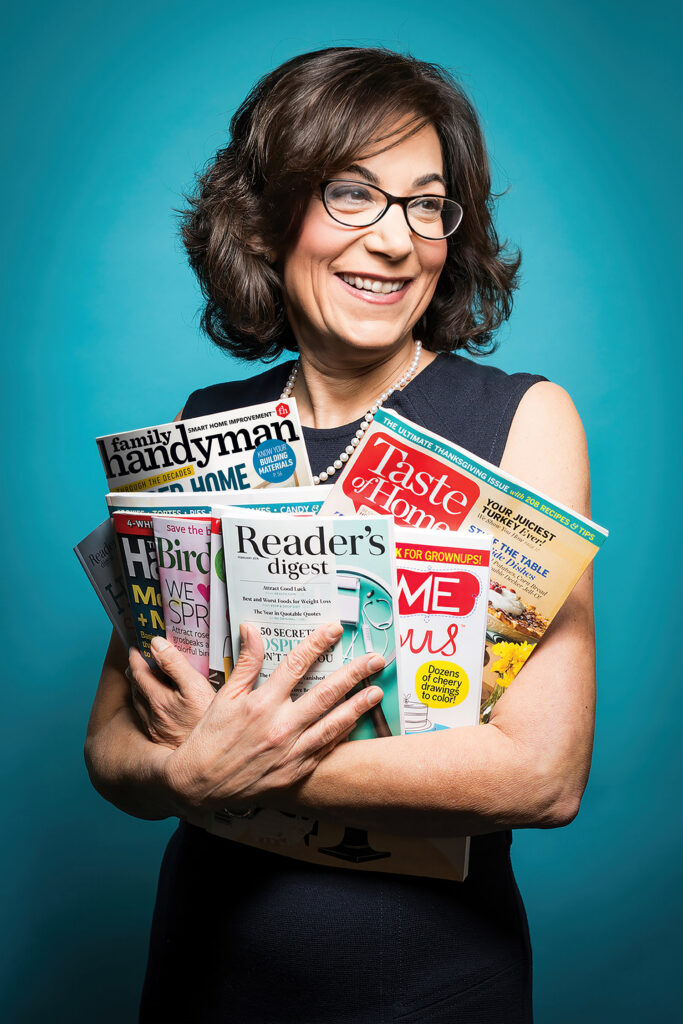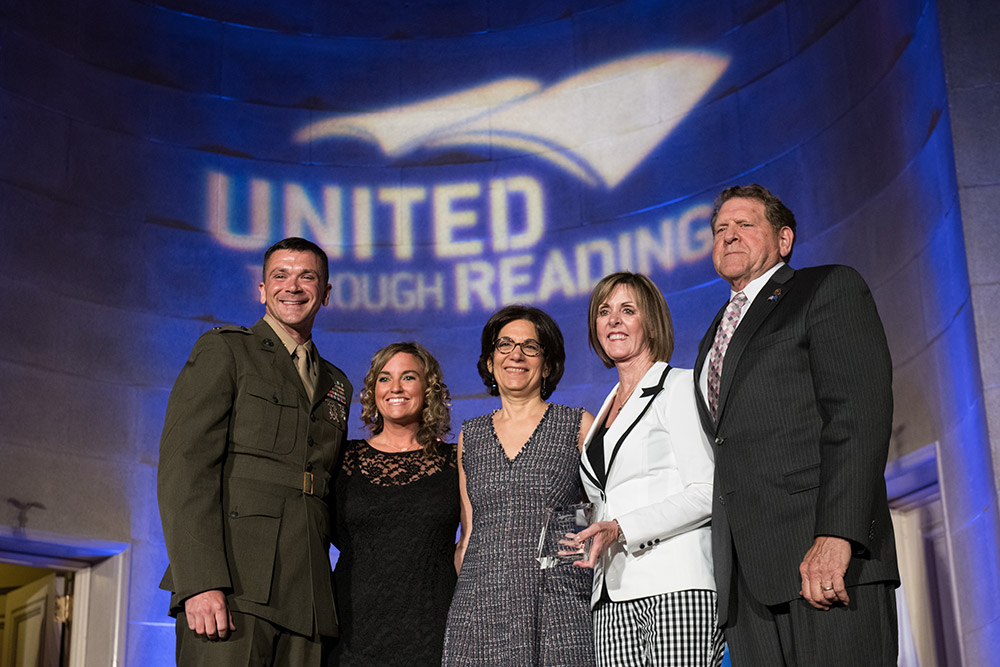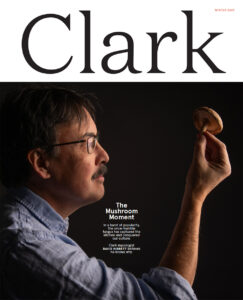Clark University Magazine
In Bonnie We Trust
 An amusing tale is shared about life in these United States.
An amusing tale is shared about life in these United States.
A cherished recipe gets passed along between generations.
A cockatoo cozies up to his canine best friend.
A man attempts a complicated skateboard trick … and tumbles into a pool.
These seemingly disparate scenes and anecdotes are all products of Trusted Media Brands — formerly known as the Reader’s Digest Association — which boasts a family of publications and platforms whose content entertains, informs, and celebrates their audiences.
And the biggest fan of it all is Bonnie Kintzer ’82, the Trusted Media Brands CEO who finds endless inspiration and opportunity in the parade of humanity marching across her magazines and, yes, skateboarding and splashing on her company’s digital channels.
In fact, she’s made quite a splash herself.
To truly understand what Kintzer has accomplished with Trusted Media Brands requires a step back into publishing history. Reader’s Digest made its first appearance in 1922 when DeWitt Wallace, while recovering from war wounds, was inspired to gather articles—one for every day of the month, on a variety of subjects and from a variety of sources — and put them into one easy-to-read volume.
Five thousand copies of that first issue were printed; in just seven years, the signature magazine’s circulation grew to 290,000. It became one of the best-selling magazines in the world, with a peak circulation of 17 million and 49 foreign editions.
But as print magazine readership began to wane, Reader’s Digest found it difficult to adapt in an increasingly digitized world. The magazine’s parent company, Reader’s Digest Association (RDA), filed for Chapter 11 bankruptcy protection twice, first in 2009 and then in 2013 — and when the company emerged from Chapter 11 in 2014, Kintzer was at its helm.
She was already very familiar with the company, having worked at RDA from 1998 to 2007 as vice president of global strategy and business redesign, general manager of North American operations, and finally as president of the u.s. publishing division. As president, she helped launch the Every Day with Rachael Ray magazine and brand, and green-lit the acquisition of AllRecipes.com (both brands have subsequently been sold).
“I definitely came back on a mission,” Kintzer says of her return as CEO. “Part of it was because I had been here before—and had been here for better days—and I was shocked at what had happened to the company.”
“We’re the anti-snark company.”
At the time, along with its flagship magazine and The Family Handyman, RDA was home to Taste of Home, Birds & Blooms, Reminisce, Country Woman, Country, and Farm & Ranch Living.
Kintzer’s first fix was to change the corporate name. “It wasn’t reflective of what the company was. Taste of Home was — and still is — a huge food brand, and The Family Handyman was number one in diy. And yet the company was known as Reader’s Digest — it seemed like a defensive posture, as opposed to being proud of both Reader’s Digest and the other brands.” So Trusted Media Brands was born.
She also recognized the need for a major culture shift. “The focus had to be digital first. We were a print-dominant company; the essence of the transformation had to be an entire shift of focus and mindset.”
The shift worked quickly and decisively. CNBC reported in 2020 that by 2017 — just three years into Kintzer’s tenure — the company had eliminated its debt. Total digital revenue grew by 98% from 2015 to 2019.
“Reader’s Digest is ‘the forever brand,’ ” Kintzer says. “People grow up with it. It’s multigenerational, and beloved within the home. I think it will always be a print magazine because that’s part of its brand identity. The issue we faced was how to protect the brand in print while expanding it digitally, which is a different experience for the reader.”
Reading a print magazine is an experience that is carefully crafted by a magazine’s creators. For example, Reader’s Digest features pages of reader-submitted jokes and anecdotes between articles tackling more serious subjects. “You read something of interest, you learn, then you chuckle,” Kintzer says. “There’s an emotional arc in a print product.”
Digital content is a different story. “If you want to read jokes, you’re going to click over to that page. If you want to read about a particular topic, you go there,” she says. “You decide.”
A common denominator does exist between print and digital: Trust. The user knows that the content they are getting is worth their time. “The value of being entertained, of learning something, is very important,” Kintzer says. “Our editors and content people are critical in ensuring that the magazine can live in another medium and still be Reader’s Digest.”

Trusted Media Brands’ publications, both print and digital, feature “content inspired by you,” Kintzer says. “We’ve always been a consumer-first company. Without the community, we don’t have anything.”
The community expanded in 2021 when TMB acquired Jukin Media, a digital firm specializing in acquiring and licensing user-generated videos. With Jukin, TMB added several popular digital brands to its portfolio — FailArmy, The Pet Collective, People Are Awesome, and WeatherSpy.
“FailArmy and The Pet Collective are juggernaut video brands that are all about people contributing and enjoying, and that is really the definition of who we are,” Kintzer says. (Often with a good side of laughter: The pool-bound skateboarder is a FailArmy video.)
The acquisition also allowed Trusted Media Brands to expand its existing content into free ad-supported tv, or fast. The Family Handyman now has a streaming channel — At Home with Family Handyman. Another channel, The Healthy, is a digital-only component of Reader’s Digest. People Are Awesome, The Pet Collective, WeatherSpy, and FailArmy are all available as streaming channels, and Taste of Home and Birds & Blooms have dynamic websites that invite the public to contribute content.
“We are here to celebrate life,” Kintzer says of the company’s brands. “We’re here to help you make a great meal, to teach you something, to make you laugh.
“We’re the anti-snark company.”
Born and raised in Brooklyn “before it was cool,” Kintzer enrolled at Clark University with a clear career goal.
“Like probably three-quarters of the student body, I went to Clark to become a psychologist,” she recalls. “Somewhere along the way, I thought about becoming a diplomat. And by the time I graduated, I wanted to go into international business.” She ultimately graduated with a major in government and international relations and went on to climb the career ladder in marketing, sales, and consulting.
“My classes broadened my sense of the world,” says Kintzer, who also interned at the Department of Commerce in Washington, D.C., and San Francisco. “It made me think so much more about the world at large—and that has definitely stayed with me.”
Kintzer insists that she hasn’t strayed far from her original plans. “I always say that being a CEO is part psychologist and part diplomat,” she says, “so I did, in fact, achieve those goals—just in a much different way.
“When you’re working in the business world, it’s important to connect with people and be interested in who they are and what motivates them. That is part of the Clark ethos, and it serves you well in the business world—or any other career. Business is about people.”
It’s a lifelong lesson, as Kintzer has proven. One that’s well worth digesting.



